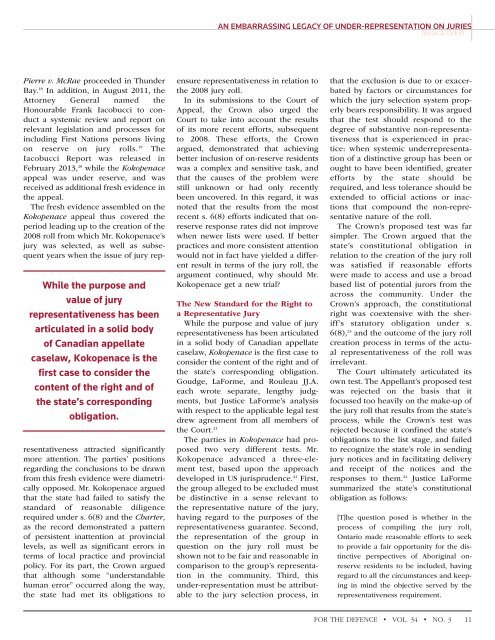FTD_Vol34_No3_web
FTD_Vol34_No3_web
FTD_Vol34_No3_web
Create successful ePaper yourself
Turn your PDF publications into a flip-book with our unique Google optimized e-Paper software.
For the Defence_34-3_Layout 1 13-08-16 10:40 AM Page 11<br />
AN EMBARRASSING LEGACY OF UNDER-REPRESENTATION ON JURIES<br />
While the purpose and<br />
value of jury<br />
representativeness has been<br />
articulated in a solid body<br />
of Canadian appellate<br />
caselaw, Kokopenace is the<br />
first case to consider the<br />
content of the right and of<br />
the state’s corresponding<br />
obligation.<br />
Pierre v. McRae proceeded in Thunder<br />
Bay. 18 In addition, in August 2011, the<br />
Attorney General named the<br />
Honourable Frank Iacobucci to conduct<br />
a systemic review and report on<br />
relevant legislation and processes for<br />
including First Nations persons living<br />
on reserve on jury rolls. 19 The<br />
Iacobucci Report was released in<br />
February 2013, 20 while the Kokopenace<br />
appeal was under reserve, and was<br />
received as additional fresh evidence in<br />
the appeal.<br />
The fresh evidence assembled on the<br />
Kokopenace appeal thus covered the<br />
period leading up to the creation of the<br />
2008 roll from which Mr. Kokopenace’s<br />
jury was selected, as well as subsequent<br />
years when the issue of jury representativeness<br />
attracted significantly<br />
more attention. The parties’ positions<br />
regarding the conclusions to be drawn<br />
from this fresh evidence were diametrically<br />
opposed. Mr. Kokopenace argued<br />
that the state had failed to satisfy the<br />
standard of reasonable diligence<br />
required under s. 6(8) and the Charter,<br />
as the record demonstrated a pattern<br />
of persistent inattention at provincial<br />
levels, as well as significant errors in<br />
terms of local practice and provincial<br />
policy. For its part, the Crown argued<br />
that although some “understandable<br />
human error” occurred along the way,<br />
the state had met its obligations to<br />
ensure representativeness in relation to<br />
the 2008 jury roll.<br />
In its submissions to the Court of<br />
Appeal, the Crown also urged the<br />
Court to take into account the results<br />
of its more recent efforts, subsequent<br />
to 2008. These efforts, the Crown<br />
argued, demonstrated that achieving<br />
better inclusion of on-reserve residents<br />
was a complex and sensitive task, and<br />
that the causes of the problem were<br />
still unknown or had only recently<br />
been uncovered. In this regard, it was<br />
noted that the results from the most<br />
recent s. 6(8) efforts indicated that onreserve<br />
response rates did not improve<br />
when newer lists were used. If better<br />
practices and more consistent attention<br />
would not in fact have yielded a different<br />
result in terms of the jury roll, the<br />
argument continued, why should Mr.<br />
Kokopenace get a new trial?<br />
The New Standard for the Right to<br />
a Representative Jury<br />
While the purpose and value of jury<br />
representativeness has been articulated<br />
in a solid body of Canadian appellate<br />
caselaw, Kokopenace is the first case to<br />
consider the content of the right and of<br />
the state’s corresponding obligation.<br />
Goudge, LaForme, and Rouleau JJ.A.<br />
each wrote separate, lengthy judgments,<br />
but Justice LaForme’s analysis<br />
with respect to the applicable legal test<br />
drew agreement from all members of<br />
the Court. 21<br />
The parties in Kokopenace had proposed<br />
two very different tests. Mr.<br />
Kokopenace advanced a three-element<br />
test, based upon the approach<br />
developed in US jurisprudence. 22 First,<br />
the group alleged to be excluded must<br />
be distinctive in a sense relevant to<br />
the representative nature of the jury,<br />
having regard to the purposes of the<br />
representativeness guarantee. Second,<br />
the representation of the group in<br />
question on the jury roll must be<br />
shown not to be fair and reasonable in<br />
comparison to the group’s representation<br />
in the community. Third, this<br />
under-representation must be attributable<br />
to the jury selection process, in<br />
that the exclusion is due to or exacerbated<br />
by factors or circumstances for<br />
which the jury selection system properly<br />
bears responsibility. It was argued<br />
that the test should respond to the<br />
degree of substantive non-representativeness<br />
that is experienced in practice:<br />
when systemic underrepresentation<br />
of a distinctive group has been or<br />
ought to have been identified, greater<br />
efforts by the state should be<br />
required, and less tolerance should be<br />
extended to official actions or inactions<br />
that compound the non-representative<br />
nature of the roll.<br />
The Crown’s proposed test was far<br />
simpler. The Crown argued that the<br />
state’s constitutional obligation in<br />
relation to the creation of the jury roll<br />
was satisfied if reasonable efforts<br />
were made to access and use a broad<br />
based list of potential jurors from the<br />
across the community. Under the<br />
Crown’s approach, the constitutional<br />
right was coextensive with the sheriff’s<br />
statutory obligation under s.<br />
6(8), 23 and the outcome of the jury roll<br />
creation process in terms of the actual<br />
representativeness of the roll was<br />
irrelevant.<br />
The Court ultimately articulated its<br />
own test. The Appellant’s proposed test<br />
was rejected on the basis that it<br />
focussed too heavily on the make-up of<br />
the jury roll that results from the state’s<br />
process, while the Crown’s test was<br />
rejected because it confined the state’s<br />
obligations to the list stage, and failed<br />
to recognize the state’s role in sending<br />
jury notices and in facilitating delivery<br />
and receipt of the notices and the<br />
responses to them. 24 Justice LaForme<br />
summarized the state’s constitutional<br />
obligation as follows:<br />
[T]he question posed is whether in the<br />
process of compiling the jury roll,<br />
Ontario made reasonable efforts to seek<br />
to provide a fair opportunity for the distinctive<br />
perspectives of Aboriginal onreserve<br />
residents to be included, having<br />
regard to all the circumstances and keeping<br />
in mind the objective served by the<br />
representativeness requirement.<br />
FOR THE DEFENCE • VOL. 34 • NO. 3<br />
11



